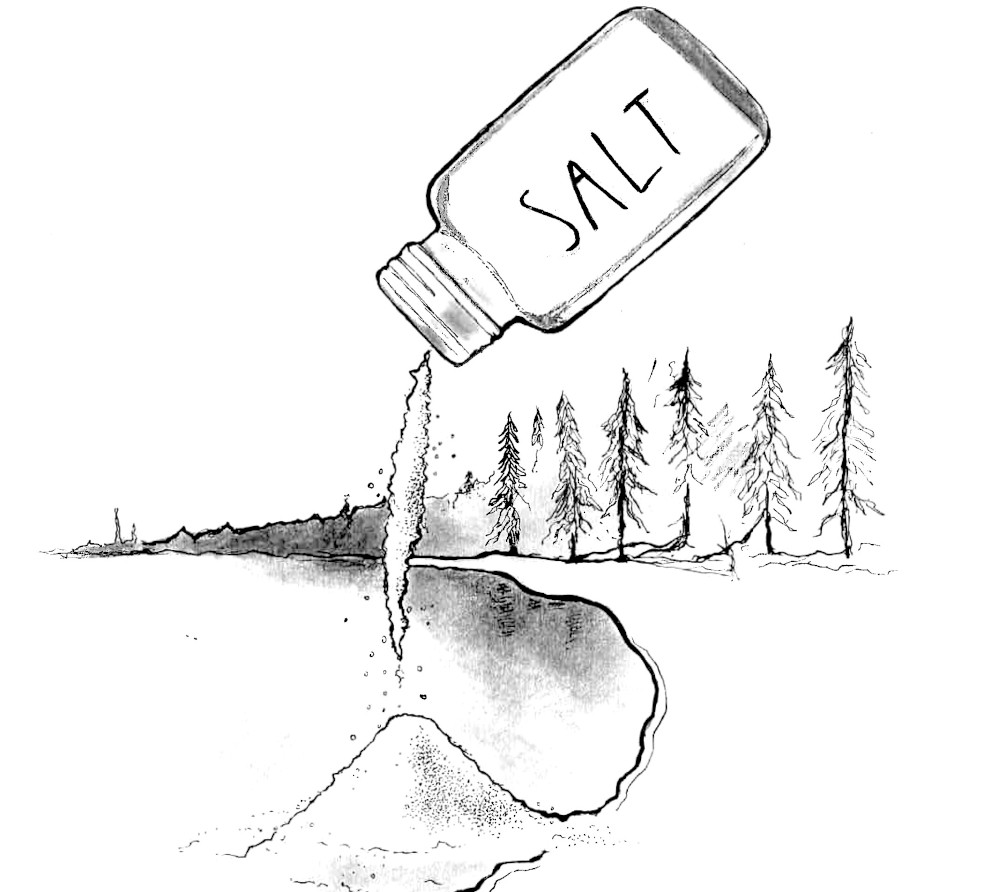Deicing’s impact on Lake Winnipeg
One green city
Most Winnipeggers can recall a time they slipped down frozen porch steps or skidded through an icy road’s stop sign. Each year, the City of Winnipeg must find ways to mitigate the dangers of local icy streets, often opting for a cheap and effective method to deice them: salt.
But research suggests salt harms surrounding freshwater ecosystems. The 26,000 tonnes of salt the City uses on Winnipeg roads and sidewalks, plus the unrecorded amount of salt private businesses and residents use, eventually washes into surrounding rivers, lakes and streams.
Runoff water from salted roads leads to salinization and elevated chloride concentrations in lakes. It poses a risk to aquatic species, decreases the quality of drinking water and can create biological dead zones near the bottom of lakes.
In general, research into water salinity is fairly new. Although cities have relied on road salt for decades, there isn’t much longterm data to help understand how it impacts the health of surrounding ecosystems.
The United States Environmental Protection Agency states that chronic chloride exposure should not exceed 230 mg/L in a healthy lake. A study from 2017 predicts that many lakes in the US could surpass this figure if current trends continue.
Braedon Humeniuk, a PhD student at University of Manitoba, is studying the ecological risk associated with salinity and salinization in Canadian freshwaters. He uses the Lake Winnipeg watershed as a case study.
He says the chloride ions from salt are not easily degraded, meaning even fairly low inputs into lakes can raise concentration over time.
Lake Winnipeg’s health is already threatened by the increased size and frequency of algae blooms, affecting the water quality, tourism and commercial fishing. Humeniuk worries salt runoff could make this worse in time.
“if nothing is done about salt runoff, there could be cascading socioeconomic effects as a result of changes to food-web structure and function,” he says.
“Zooplankton have been found to be sensitive to changes in salinity, and not only are they the primary food source of smaller fish, but they also feed on algae. Therefore, reductions in zooplankton populations from rising salinity levels could increase algal blooms and reduce fish populations.”
In 2015, the City of Winnipeg began using beet juice to deice roads in an effort to be more environmentally friendly. The city is currently using 100,000 litres of desugared beet juice mixed with road salt a year. Beet juice is effective in temperatures as low as -35ºC and is biodegradable.
But Humeniuk isn’t sold on the switch. Beet juice is filled with nutrients that can increase the growth of plants and algae when it ends up in lakes, creating even more algae blooms. He would like the City to instead make winter tires more accessible and improve road and sidewalk maintenance by physically clearing them.
Winnipeggers still need to get around, and it’s remarkably difficult to drive, walk or bike around after an ice storm.
At the same time, people need to be mindful that much of what goes on local streets, sidewalks and parking lots ends up in nearby water supplies.
Allyn Lyons is a graduate of the University of Winnipeg and Red River College’s Creative Communications joint-degree program. It’s pronounced uh-lyn.
Published in Volume 77, Number 15 of The Uniter (January 19, 2023)








